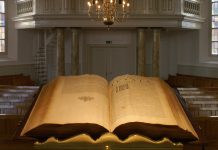In his desire to secure an heir to the throne, Henry VIII set off a domino effect that would ultimately change the face of America and the world.
By declaring himself head of the Church of England, Henry VIII became the first European monarch to successfully deny papal supremacy and the first to assume the position of head of the Church. A third innovation concerned the nature of his ecclesiastical reform. Henry VIII was a contemporary of Luther and the other Protestant reformers, but “Protestantism neither caused nor was achieved” by the separation of the Church of England from the Vatican. In the long run, however, “Henry VIII’s denial of papal authority probably was indispensable to the eventual emergence of Protestantism.”[1]
What is more important today, however, is that Henry’s gesture set in motion a domino effect with a remarkable end: the religious diversity of America and the separation of church and state in the New World. In other words, the religious freedom that characterises America today and influences the whole world has its historical roots in the events of Henry VIII’s England.
The king’s big problem
Henry was married to the Spanish princess Catherine of Aragon, the widow of his brother Arthur. The marriage, which seemed to indicate a political alliance, had received a papal dispensation[2] and did not initially lack passion.[3] By the time the queen was 40, however, she had lost four pregnancies and a baby boy within days of birth. The lack of an heir had become acute, and although Catherine had given birth to a daughter (the future Queen Mary Tudor), Henry did not pin his hopes on such a succession.
Meanwhile, the alliance with Spain no longer seemed such a good idea, and the pious Henry was increasingly haunted by the idea that the lack of an heir was due to the unbiblical nature of his marriage to Catherine.[4] In addition, Henry loved Anne Boleyn,[5] but the fact that he wanted her to be his wife at all costs, when he could easily have had her as his mistress,[6] shows that it was not passion that drove him to seek a divorce, but the need to ensure the continuity of the dynasty.
From “Defender of the Faith” to schismatic
Henry’s loyalty to Catholicism was unquestionable. In 1521 he was even awarded the title of “Defender of the Faith” by the Pope for his theological refutation of Martin Luther. Getting the Pope’s approval for the divorce should have been easy. But Catherine of Aragon was the aunt of the Emperor Charles V, and Pope Clement VII feared him. So Clement refused Henry’s request for a divorce and warned him that he would be excommunicated if he remarried.
For the King of England, however, there was no going back. Thomas Cranmer, who was in favour of the royal divorce, was consecrated Archbishop of Canterbury and shortly afterwards declared the King’s marriage to Catherine null and void, thus validating his marriage to the already pregnant Anne Boleyn. In June 1533, Anne was crowned Queen of England and on 7 September she gave birth to Elizabeth Tudor (the future Queen Elizabeth I).
In 1534, Henry’s political machinations were completed with the passing of several acts. The Act of Succession ensured that the crown would pass to his son. The Act of Supremacy made him the Supreme Head of the Church, and the Treasons Act laid down the death penalty for anyone who denied his supremacy. It was under the latter Act that Henry executed Sir Thomas More, his best friend. The union of church and state in the person of the king created a repressive regime even harsher than the medieval one. It has been said that the king’s self-image as “arbiter” of the Church could easily turn into paranoia.[7] In 1539, for example, he burned at the stake three Protestants and three Catholics loyal to the Pope on the same day to demonstrate his impartiality.
Was Henry a reformer?
Henry was a devout Catholic who wanted to preserve Catholicism in the new Church of England, and his minimal reforms were a natural consequence of breaking with Rome: he abolished prayers to the Pope, monasteries (from which Henry acquired vast estates and wealth), the veneration of saints (which included pilgrimages and relics) and the worship of icons or holy objects. Instead, he placed an English copy of the Bible in every church, but when the English showed a great interest in reading it, the king feared the consequences and restricted access to the Bible for the common people.
In terms of doctrine, the Church of England was shaped by the king’s beliefs, which no one dared to contradict. As a result, theology was “both fluid and unique…. Henry’s idiosyncratic personal faith resulted in a peculiar official theology.”[8] When he sought the support of German Lutherans against the Catholic kingdoms that threatened him with invasion, Henry temporarily favoured some Lutheran ideas, but his schismatic church never became Protestant. Protestantism would only find supporters in his descendants, Edward and Elizabeth.
Henry was not a reformer per se, but his struggle for an heir set the stage for profound change in England. By the latter part of his reign there were already groups in England interested in the ideas of Luther, Zwingli, Clavin, Bucer, and the Anabaptists. Religious diversity had so permeated England, hitherto one of the most devout Catholic countries, that the king’s reprisals could no longer prevent it from spreading across the island and, through English colonists, to the New World.
Norel Iacob is editor-in-chief of Signs of the Times Romania and ST Network.



















